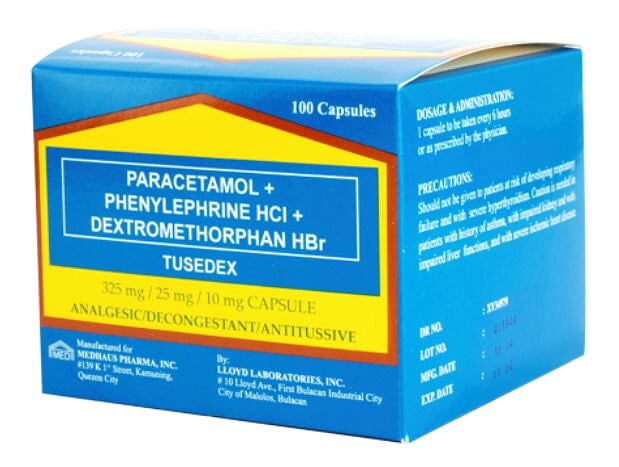Tusedex (Paracetamol + Phenylephrine + Dextromethorphan)
Tusedex (Paracetamol + Phenylephrine + Dextromethorphan)
Couldn't load pickup availability

Paracetamol, also known as acetaminophen, is a medication used to treat pain and fever. It is typically used for mild to moderate pain relief. Evidence is mixed for its use to relieve fever in children. It is often sold in combination with other medications, such as in many cold medications. Paracetamol is also used for severe pain, such as cancer pain and pain after surgery, in combination with opioid pain medication. It is typically used either by mouth or rectally, but is also available by injection into a vein. Effects last between two and four hours.
Phenylephrine is a medication primarily used as a decongestant, to dilate the pupil, to increase blood pressure, and to relieve hemorrhoids. While marketed as a decongestant, taken by mouth at recommended doses it is of unclear benefit for hay fever. It can be taken by mouth, given by injection into a vein or muscle, or applied to the skin.
Dextromethorphan (DXM or DM) is a medication most often used as a cough suppressant in over-the-counter cold and cough medicines. It is sold in syrup, tablet, spray, and lozenge forms.
It is in the morphinan class of medications with sedative, dissociative, and stimulant properties (at lower doses). Dextromethorphan posseses only a minimal degree of the mu-opioid activity typical of morphinan compounds and exerts its therapeutic effects through several other receptors. In its pure form, dextromethorphan occurs as a white powder.
DXM is also used recreationally. When exceeding approved dosages, dextromethorphan acts as a dissociative hallucinogen. It has multiple mechanisms of action, including actions as a nonselective serotonin reuptake inhibitor and a sigma-1 receptor agonist. DXM and its major metabolite, dextrorphan, also block the NMDA glutamate receptor at high doses, which produces effects similar to other dissociative anesthetics such as ketamine, nitrous oxide, and phencyclidine.
Content
Content
Share

